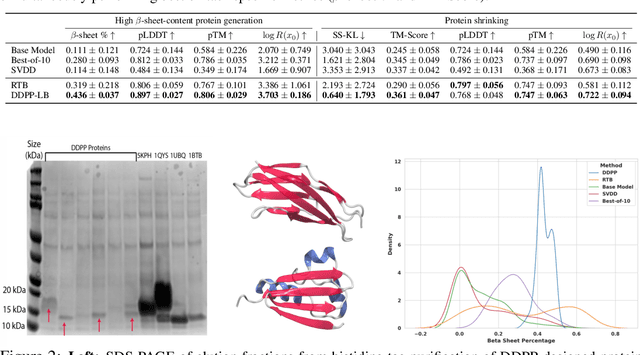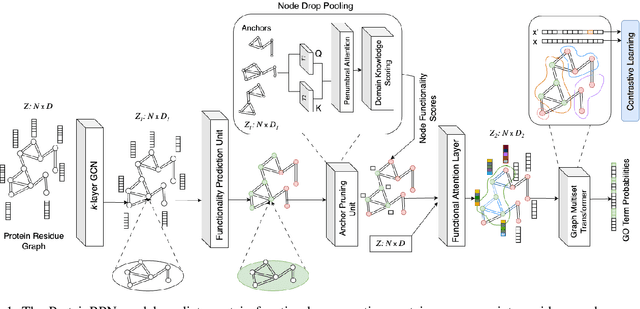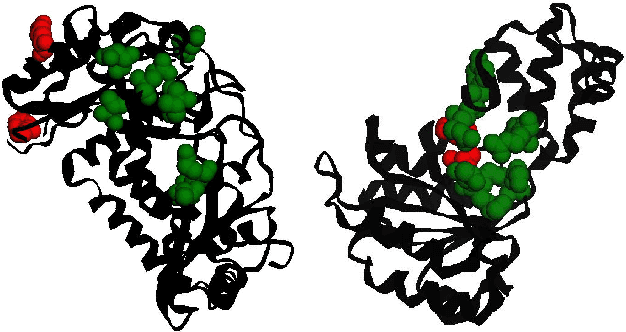Protein Secondary Structure Prediction
Protein secondary-structure prediction is a vital task in bioinformatics, aiming to determine the arrangement of amino acids in proteins, including α-helices, β-sheets, and coils. By analyzing amino acid sequences, computational algorithms and machine learning techniques predict these structural elements. This knowledge is crucial for understanding protein function and interactions. While progress has been made, challenges remain, especially with non-local interactions and low sequence homology. Advancements in machine learning hold promise for improving prediction accuracy, furthering our understanding of protein biology.
Papers and Code
ProtPainter: Draw or Drag Protein via Topology-guided Diffusion
Apr 19, 2025Recent advances in protein backbone generation have achieved promising results under structural, functional, or physical constraints. However, existing methods lack the flexibility for precise topology control, limiting navigation of the backbone space. We present ProtPainter, a diffusion-based approach for generating protein backbones conditioned on 3D curves. ProtPainter follows a two-stage process: curve-based sketching and sketch-guided backbone generation. For the first stage, we propose CurveEncoder, which predicts secondary structure annotations from a curve to parametrize sketch generation. For the second stage, the sketch guides the generative process in Denoising Diffusion Probabilistic Modeling (DDPM) to generate backbones. During this process, we further introduce a fusion scheduling scheme, Helix-Gating, to control the scaling factors. To evaluate, we propose the first benchmark for topology-conditioned protein generation, introducing Protein Restoration Task and a new metric, self-consistency Topology Fitness (scTF). Experiments demonstrate ProtPainter's ability to generate topology-fit (scTF > 0.8) and designable (scTM > 0.5) backbones, with drawing and dragging tasks showcasing its flexibility and versatility.
Customizing Spider Silk: Generative Models with Mechanical Property Conditioning for Protein Engineering
Apr 11, 2025The remarkable mechanical properties of spider silk, including its tensile strength and extensibility, are primarily governed by the repetitive regions of the proteins that constitute the fiber, the major ampullate spidroins (MaSps). However, establishing correlations between mechanical characteristics and repeat sequences is challenging due to the intricate sequence-structure-function relationships of MaSps and the limited availability of annotated datasets. In this study, we present a novel computational framework for designing MaSp repeat sequences with customizable mechanical properties. To achieve this, we developed a lightweight GPT-based generative model by distilling the pre-trained ProtGPT2 protein language model. The distilled model was subjected to multilevel fine-tuning using curated subsets of the Spider Silkome dataset. Specifically, we adapt the model for MaSp repeat generation using 6,000 MaSp repeat sequences and further refine it with 572 repeats associated with experimentally determined fiber-level mechanical properties. Our model generates biologically plausible MaSp repeat regions tailored to specific mechanical properties while also predicting those properties for given sequences. Validation includes sequence-level analysis, assessing physicochemical attributes and expected distribution of key motifs as well as secondary structure compositions. A correlation study using BLAST on the Spider Silkome dataset and a test set of MaSp repeats with known mechanical properties further confirmed the predictive accuracy of the model. This framework advances the rational design of spider silk-inspired biomaterials, offering a versatile tool for engineering protein sequences with tailored mechanical attributes.
PLM-eXplain: Divide and Conquer the Protein Embedding Space
Apr 09, 2025Protein language models (PLMs) have revolutionised computational biology through their ability to generate powerful sequence representations for diverse prediction tasks. However, their black-box nature limits biological interpretation and translation to actionable insights. We present an explainable adapter layer - PLM-eXplain (PLM-X), that bridges this gap by factoring PLM embeddings into two components: an interpretable subspace based on established biochemical features, and a residual subspace that preserves the model's predictive power. Using embeddings from ESM2, our adapter incorporates well-established properties, including secondary structure and hydropathy while maintaining high performance. We demonstrate the effectiveness of our approach across three protein-level classification tasks: prediction of extracellular vesicle association, identification of transmembrane helices, and prediction of aggregation propensity. PLM-X enables biological interpretation of model decisions without sacrificing accuracy, offering a generalisable solution for enhancing PLM interpretability across various downstream applications. This work addresses a critical need in computational biology by providing a bridge between powerful deep learning models and actionable biological insights.
Comprehensive benchmarking of large language models for RNA secondary structure prediction
Oct 21, 2024Inspired by the success of large language models (LLM) for DNA and proteins, several LLM for RNA have been developed recently. RNA-LLM uses large datasets of RNA sequences to learn, in a self-supervised way, how to represent each RNA base with a semantically rich numerical vector. This is done under the hypothesis that obtaining high-quality RNA representations can enhance data-costly downstream tasks. Among them, predicting the secondary structure is a fundamental task for uncovering RNA functional mechanisms. In this work we present a comprehensive experimental analysis of several pre-trained RNA-LLM, comparing them for the RNA secondary structure prediction task in an unified deep learning framework. The RNA-LLM were assessed with increasing generalization difficulty on benchmark datasets. Results showed that two LLM clearly outperform the other models, and revealed significant challenges for generalization in low-homology scenarios.
Steering Masked Discrete Diffusion Models via Discrete Denoising Posterior Prediction
Oct 10, 2024



Generative modeling of discrete data underlies important applications spanning text-based agents like ChatGPT to the design of the very building blocks of life in protein sequences. However, application domains need to exert control over the generated data by steering the generative process - typically via RLHF - to satisfy a specified property, reward, or affinity metric. In this paper, we study the problem of steering Masked Diffusion Models (MDMs), a recent class of discrete diffusion models that offer a compelling alternative to traditional autoregressive models. We introduce Discrete Denoising Posterior Prediction (DDPP), a novel framework that casts the task of steering pre-trained MDMs as a problem of probabilistic inference by learning to sample from a target Bayesian posterior. Our DDPP framework leads to a family of three novel objectives that are all simulation-free, and thus scalable while applying to general non-differentiable reward functions. Empirically, we instantiate DDPP by steering MDMs to perform class-conditional pixel-level image modeling, RLHF-based alignment of MDMs using text-based rewards, and finetuning protein language models to generate more diverse secondary structures and shorter proteins. We substantiate our designs via wet-lab validation, where we observe transient expression of reward-optimized protein sequences.
ProteinRPN: Towards Accurate Protein Function Prediction with Graph-Based Region Proposals
Sep 01, 2024



Protein function prediction is a crucial task in bioinformatics, with significant implications for understanding biological processes and disease mechanisms. While the relationship between sequence and function has been extensively explored, translating protein structure to function continues to present substantial challenges. Various models, particularly, CNN and graph-based deep learning approaches that integrate structural and functional data, have been proposed to address these challenges. However, these methods often fall short in elucidating the functional significance of key residues essential for protein functionality, as they predominantly adopt a retrospective perspective, leading to suboptimal performance. Inspired by region proposal networks in computer vision, we introduce the Protein Region Proposal Network (ProteinRPN) for accurate protein function prediction. Specifically, the region proposal module component of ProteinRPN identifies potential functional regions (anchors) which are refined through the hierarchy-aware node drop pooling layer favoring nodes with defined secondary structures and spatial proximity. The representations of the predicted functional nodes are enriched using attention mechanisms and subsequently fed into a Graph Multiset Transformer, which is trained with supervised contrastive (SupCon) and InfoNCE losses on perturbed protein structures. Our model demonstrates significant improvements in predicting Gene Ontology (GO) terms, effectively localizing functional residues within protein structures. The proposed framework provides a robust, scalable solution for protein function annotation, advancing the understanding of protein structure-function relationships in computational biology.
mRNA2vec: mRNA Embedding with Language Model in the 5'UTR-CDS for mRNA Design
Aug 16, 2024Messenger RNA (mRNA)-based vaccines are accelerating the discovery of new drugs and revolutionizing the pharmaceutical industry. However, selecting particular mRNA sequences for vaccines and therapeutics from extensive mRNA libraries is costly. Effective mRNA therapeutics require carefully designed sequences with optimized expression levels and stability. This paper proposes a novel contextual language model (LM)-based embedding method: mRNA2vec. In contrast to existing mRNA embedding approaches, our method is based on the self-supervised teacher-student learning framework of data2vec. We jointly use the 5' untranslated region (UTR) and coding sequence (CDS) region as the input sequences. We adapt our LM-based approach specifically to mRNA by 1) considering the importance of location on the mRNA sequence with probabilistic masking, 2) using Minimum Free Energy (MFE) prediction and Secondary Structure (SS) classification as additional pretext tasks. mRNA2vec demonstrates significant improvements in translation efficiency (TE) and expression level (EL) prediction tasks in UTR compared to SOTA methods such as UTR-LM. It also gives a competitive performance in mRNA stability and protein production level tasks in CDS such as CodonBERT.
Geometric Self-Supervised Pretraining on 3D Protein Structures using Subgraphs
Jun 20, 2024Protein representation learning aims to learn informative protein embeddings capable of addressing crucial biological questions, such as protein function prediction. Although sequence-based transformer models have shown promising results by leveraging the vast amount of protein sequence data in a self-supervised way, there is still a gap in applying these methods to 3D protein structures. In this work, we propose a pre-training scheme going beyond trivial masking methods leveraging 3D and hierarchical structures of proteins. We propose a novel self-supervised method to pretrain 3D graph neural networks on 3D protein structures, by predicting the distances between local geometric centroids of protein subgraphs and the global geometric centroid of the protein. The motivation for this method is twofold. First, the relative spatial arrangements and geometric relationships among different regions of a protein are crucial for its function. Moreover, proteins are often organized in a hierarchical manner, where smaller substructures, such as secondary structure elements, assemble into larger domains. By considering subgraphs and their relationships to the global protein structure, the model can learn to reason about these hierarchical levels of organization. We experimentally show that our proposed pertaining strategy leads to significant improvements in the performance of 3D GNNs in various protein classification tasks.
A Protein Structure Prediction Approach Leveraging Transformer and CNN Integration
Mar 08, 2024Proteins are essential for life, and their structure determines their function. The protein secondary structure is formed by the folding of the protein primary structure, and the protein tertiary structure is formed by the bending and folding of the secondary structure. Therefore, the study of protein secondary structure is very helpful to the overall understanding of protein structure. Although the accuracy of protein secondary structure prediction has continuously improved with the development of machine learning and deep learning, progress in the field of protein structure prediction, unfortunately, remains insufficient to meet the large demand for protein information. Therefore, based on the advantages of deep learning-based methods in feature extraction and learning ability, this paper adopts a two-dimensional fusion deep neural network model, DstruCCN, which uses Convolutional Neural Networks (CCN) and a supervised Transformer protein language model for single-sequence protein structure prediction. The training features of the two are combined to predict the protein Transformer binding site matrix, and then the three-dimensional structure is reconstructed using energy minimization.
PatchProt: Hydrophobic patch prediction using protein foundation models
May 24, 2024Hydrophobic patches on protein surfaces play important functional roles in protein-protein and protein-ligand interactions. Large hydrophobic surfaces are also involved in the progression of aggregation diseases. Predicting exposed hydrophobic patches from a protein sequence has been shown to be a difficult task. Fine-tuning foundation models allows for adapting a model to the specific nuances of a new task using a much smaller dataset. Additionally, multi-task deep learning offers a promising solution for addressing data gaps, simultaneously outperforming single-task methods. In this study, we harnessed a recently released leading large language model ESM-2. Efficient fine-tuning of ESM-2 was achieved by leveraging a recently developed parameter-efficient fine-tuning method. This approach enabled comprehensive training of model layers without excessive parameters and without the need to include a computationally expensive multiple sequence analysis. We explored several related tasks, at local (residue) and global (protein) levels, to improve the representation of the model. As a result, our fine-tuned ESM-2 model, PatchProt, cannot only predict hydrophobic patch areas but also outperforms existing methods at predicting primary tasks, including secondary structure and surface accessibility predictions. Importantly, our analysis shows that including related local tasks can improve predictions on more difficult global tasks. This research sets a new standard for sequence-based protein property prediction and highlights the remarkable potential of fine-tuning foundation models enriching the model representation by training over related tasks.
 Add to Chrome
Add to Chrome Add to Firefox
Add to Firefox Add to Edge
Add to Edge